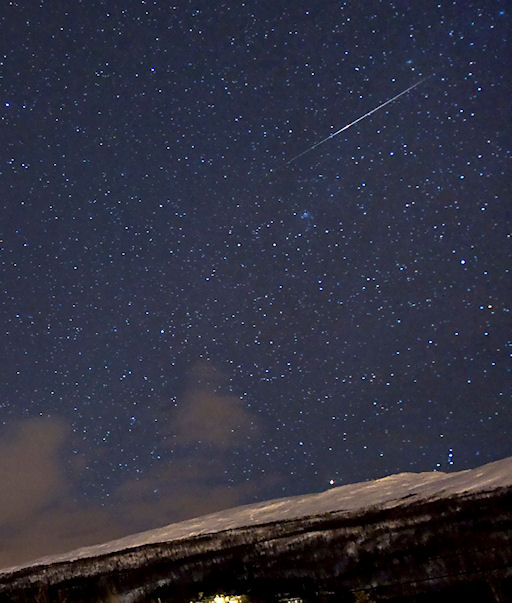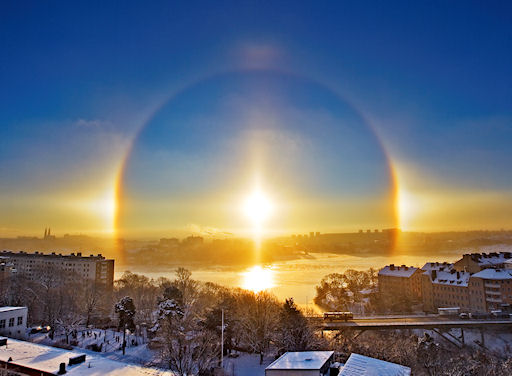iPHONE VS ANDROID! Actually, it doesn't matter which phone you carry. Our cool, new app turns both smartphones into field-tested satellite trackers. Learn more. | | |
AURORA WATCH: High-latitude sky watchers should be alert for auroras on Dec. 10th and 11th when a solar wind stream is expected to hit Earth's magnetic field. NOAA forecasters estimate a 20%-50% chance of geomagnetic activity.
GEMINID METEOR SHOWER: This week, Earth is entering a stream of debris from asteroid 3200 Phaethon, source of the mysterious Geminid meteor shower. Although the shower's peak won't come until Dec. 13th and 14th, people are already seeing a smattering of bright shooting stars. Fredrik Broms photographed this Geminid streaking over the snowy hills of Kvaløya, Norway, on Dec. 7th:

Geminid meteor rates are low now, less than 5 to 10 per hour, but they will climb ten-fold early next week when Earth passes through a denser part of the debris stream. People who go outside between midnight and sunrise on Tuesday, Dec. 14th, could count as many as 120 Geminds per hour. Urban light pollution will reduce number of visible meteors by factors of 2 to 5, so get away from city lights if you can. A rural setting is best for meteor watching.
PLAN B: Got clouds? If you can't see the Geminids, you can listen to them instead on Space Weather Radio. We're transmitting live meteor echoes from the US Air Force Space Surveillance Radar in Kickapoo, Texas.
BUSY ICE HALO: In Stockholm, Sweden, the sun was only up for a little while Wednesday, but it made good use of its time. Sunbeams lanced through ice crystals in the air, producing a busy halo of surpassing beauty:

"This was the most spectacular sun halo I have seen in recent years from Stockholm," says photographer Peter Rosén. "It was visible for the whole (short) day." In addition to the sundogs, upper tangent arc, and 22° halo captured in the snapshot above, Rosén also witnessed "a 46° outer halo and a circumzenithal arc as ice crystals blew in gusts across the sun. What a show!"
Now is the time of year when low-hanging suns shine through high-floating ice to produce such vistas. People of the northern hemisphere should be alert for halos.
more images: from Jörgen Blom of Stockholm, Sweden; from Merelyn Davis of Burbank, CA; from Paul Ballard of Kungälv, Sweden; from Gary Brekke of Fargo, ND; from Shawn Johnston of Fargo, ND; from Joanna Fengler of Poznan, Poland
November 2010 Aurora Gallery
[previous Novembers: 2009, 2008, 2007, 2006, 2004, 2003, 2002, 2001, 2000]
Potentially Hazardous Asteroids (
PHAs) are space rocks larger than approximately 100m that can come closer to Earth than 0.05 AU. None of the known PHAs is on a collision course with our planet, although astronomers are finding
new ones all the time.
On December 10, 2010 there were 1167 potentially hazardous asteroids.
Notes: LD means "Lunar Distance." 1 LD = 384,401 km, the distance between Earth and the Moon. 1 LD also equals 0.00256 AU. MAG is the visual magnitude of the asteroid on the date of closest approach. | | The official U.S. government space weather bureau |
| | The first place to look for information about sundogs, pillars, rainbows and related phenomena. |
| | Researchers call it a "Hubble for the sun." SDO is the most advanced solar observatory ever. |
| | 3D views of the sun from NASA's Solar and Terrestrial Relations Observatory |
| | Realtime and archival images of the Sun from SOHO. |
| | from the NOAA Space Environment Center |
| | the underlying science of space weather |

